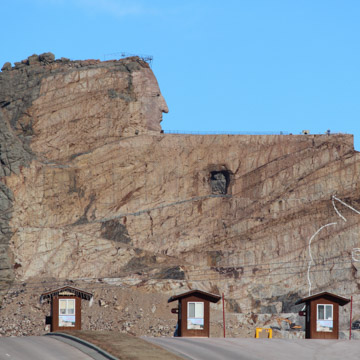The Crazy Horse Memorial is located between Hill City and Custer in the Black Hills of South Dakota. Begun in 1948, the monument is still under construction. The colossal sculpture will depict Crazy Horse, the Oglala Lakota warrior, riding a horse and pointing into the distance. When finished, it will be one of the world’s tallest sculptures at 641 feet long and 563 feet high (Crazy Horse’s face measures 87 feet high). Chief Henry Standing Bear, a Lakota elder, commissioned Korczak Ziolkowski to design and sculpt the monument, which he intended as a counterpoint to the recently completed Mount Rushmore (1927–1941, Gutzon Borglum). The monument depicting four American president’s heads (each 60 feet high) is located about 17 miles east. Ziolkowski was a sculptor’s assistant on the Mount Rushmore project, and dedicated the final 36 years of his life to the Crazy Horse Memorial, where he is now buried.
The monument is carved out of Thunderhead Mountain, a site sacred to the Oglala Lakota. For this reason, controversy has surrounded its creation. Crazy Horse’s descendants, in particular, feel the monument is not only a desecration to Lakota culture but also an inappropriate tribute to a leader known for his humility.
In addition to the monument, Standing Bear envisioned the site as an educational and cultural center. The master plan includes the Indian Museum of North America and the American Educational and Cultural Center, and is also home to the Indian University of North America, a satellite campus of the University of South Dakota. The site is run by the Crazy Horse Memorial Foundation, a nonprofit organization that does not accept federal or state funding.
Ziolkowski initially began carving the horse’s head, but after his death in 1982, his wife, Ruth, took over the project and shifted the focus to Crazy Horse’s face, believing that it would draw more visitors and thus, more funding for its completion. The granite is carved using carefully placed explosives, although in recent years the process has become more high-tech with the use of laser measuring devices. Seams and cracks in the rock pose challenges and have resulted in deviations from the original model developed by Ziolkowski. Regardless, progress continues and the full head of Crazy Horse is now complete; work on the horse’s head has been the focus of recent work.

